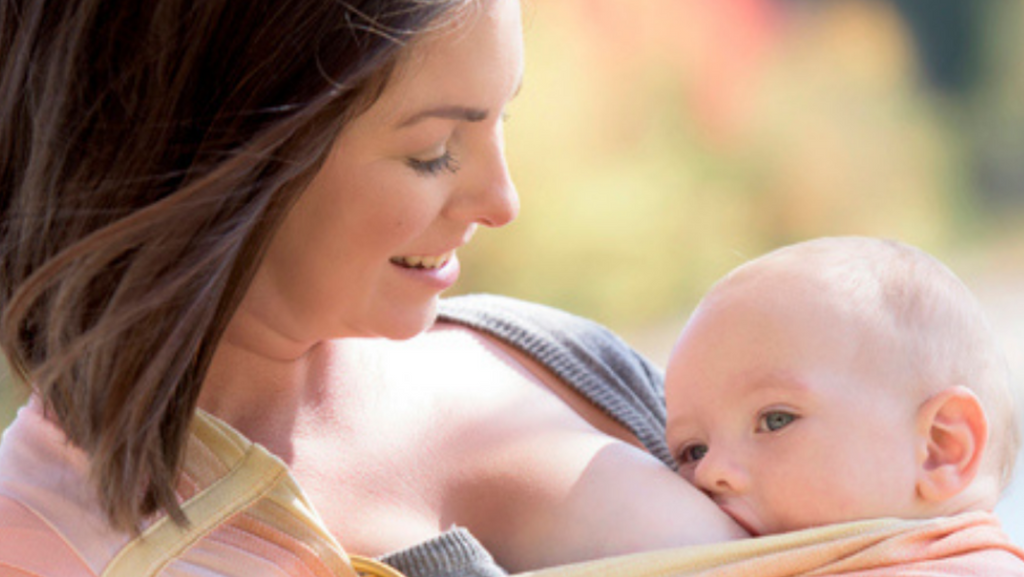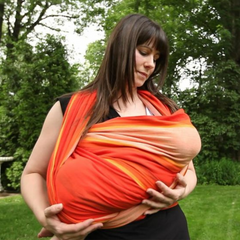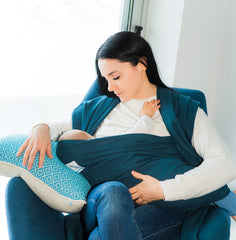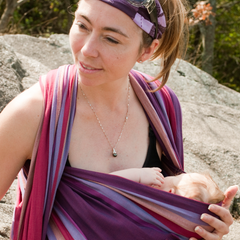
Breastfeeding has many advantages, among which is the creation of a precious bond between mother and baby. Is it possible to combine breastfeeding’s unique experience with that of babywearing, which is the carrying of a baby on ourselves by using a baby wrap or baby carrier? The answer’s yes! Breastfeeding while babywearing is a practical yet intimate way of feeding your baby and all the while reinforcing your bond with him.
In this article, we’ll get started by addressing many parents’ worries regarding the dangers of breastfeeding while babywearing. We’ll then explore its advantages, the positions to achieve it, the baby wraps and baby carriers recommended for it and the precautions to take to ensure the comfort and safety of the mother and her baby.
1. Is breastfeeding while babywearing dangerous?
This question is raised often among parents, and it’s perfectly normal: you love your child and want to make sure you’re not putting him in a situation where his safety is put at risk.
Let’s start by saying that there is no more danger in using a baby carrier or baby wrap than in the use of any other baby product used to take care of him, carrying him, or play with him. Risks are minimal and the benefits of babywearing exceed by far the risk of injuries. While we’re on the topic, did you know that babywearing increases the chances of survival of premature babies?
The main danger to avoid when babywearing is the risk of asphyxia and suffocation. By staying vigilant, by taking into account how we feel while breastfeeding and verifying that the baby is correctly positioned and his face unobstructed, it’s just not possible for your baby to run into these problems. It should be said that this advice needs to be followed to the letter so as to not put your child in harm’s way. During breastfeeding, it’s also important to not have any pressure put on the baby’s head so that he can turn his head away quickly should he choke on milk by drinking too fast, for example.
Another recommendation is to practice breastfeeding and babywearing separately at first so as to master each of them enough before attempting to combine them. There are specialists and organizations out there to help you. Read this list of resources in our previous article. Lastly, learn to trust yourself! By being vigilant, you’ll be perfectly able to do both.
2. The advantages of breastfeeding while babywearing:
Now that we’ve demystified the idea that breastfeeding while babywearing can be dangerous, let’s talk about why babywearing can facilitate it. An argument can be made in its favor regarding the position of the baby: while babywearing, the baby is already leaning on his mother and in a position already ideal for breastfeeding. In addition to this, babywearing makes breastfeeding in public much more comfortable by way of making it discreet and comfortable.
Breastfeeding, just like babywearing, can be an opportunity for skin to skin contact between mother and child, which will benefit their bonding, which is the creation of the emotional connection between baby and parent and the reinforcing of their sense of safety, closeness and mutual trust. By combining babywearing to breastfeeding, you extend these benefits beyond your breastfeeding session and foster a harmonious development of the baby.
3. How should you position the baby while breastfeeding?
Make sure that your baby’s head is properly supported and that no pressure is put on its head and that it remains visible and unobstructed. Adjust your baby carrier or baby wrap so as to free one breast to feed your baby while holding it safely close to you.
4. Which baby carrier or baby wrap is best for breastfeeding?
Here are a few options you’ll often see recommended for breastfeeding while babywearing:
- A woven baby wrap : This is our number 1 choice for babywearing as it offers a great variety of adjustments and allows you to keep your baby in any desired position and offers great stability and support.
- A stretchy baby wrap: This is also a good choice, although a little harder to adjust due to its stretch. It will still give you the same kind of support and level of discretion as the woven wrap.
- Mei Tai and structured/hybrid baby carriers (EvöAir bblüv and PöpNgo): These can be used while breastfeeding by adjusting their shoulder straps and fabric to allow access to your breast. Make sure that your model provides good support for your baby’s weight and secure adjustments.
For demonstrations on how to position your baby for breastfeeding, watch our Facebook Live on How to Breastfeed While Babywearing.
Before we finish up, let’s mention that it’s necessary to breastfeed while babywearing in a safe environment and to always keep an eye one your baby as he drinks. Since breastfeeding a newborn can be a bit stressful, you shouldn’t hesitate to ask for help from a breastfeeding godmother, a lactation consultant or specialized organizations like Ligue La lèche. During your first few breastfeeding sessions, ask your partner or another family member for help, as it will reassure you.
We aren’t all equal when it comes to breastfeeding and it’s not always easy to do for all moms. Keep in mind that it’s not a catastrophe if it’s too difficult for you. What matters is your wellbeing and a mom who feels great and who’s happy is what matters most to your child.
*****
Watch an earlier Facebook Live event for advice on breastfeeding while babywearing by clicking here. If you have questions or worries about the topic, you can write to our founder Christine Duhaime by writing at info@chimparoo.ca.
You can also take a look at the resources we’ve prepared to turn you into a carrier of happiness:
- Our blog explores different topics around parenthood and babywearing each month.
- Our YouTube channel to try babywearing positions with different wraps and carriers to help you in your day-to-day.
- Our FAQ should be able to cover most of the questions you’ll have before getting started in babywearing.






Share:
5 Tips for Future First-Time Dads
3 Steps to Master Physiological Babywearing